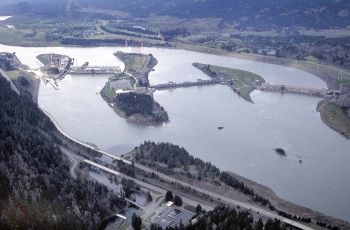
Publisher:
Bonnie King
CONTACT:
Newsroom@Salem-news.com
Advertising:
Adsales@Salem-news.com

~Truth~
~Justice~
~Peace~
TJP
Feb-20-2009 07:24

 TweetFollow @OregonNews
TweetFollow @OregonNews
BPA Outlines Major Transmission Expansion for Pacific Northwest
Salem-News.comEconomic stimulus package provides capital to help BPA move forward with new transmission line, create jobs.
 Photo courtesy: BPA |
(PORTLAND, Ore.) - Thanks in part to new borrowing authority contained in the American Recovery and Reinvestment Act signed into law earlier this week by President Barack Obama, the Bonneville Power Administration has decided to build a major new transmission project - the McNary-John Day 500-kilovolt transmission line.
The $246 million project creates about 700 jobs at its peak. When energized in late 2012, the line will allow BPA to provide transmission service to more than 870 megawatts of energy, including service for more than 700 megawatts of new wind energy. Work will begin this spring.
The plans being announced today were energized by an additional $3.25 billion in borrowing authority for BPA from the U.S. Treasury for capital projects in the newly signed law.
The increased access to capital removed a major uncertainty for BPA, helping enable the decision to proceed with this project.
"This project creates jobs and enhances our nation's energy independence while expanding the Pacific Northwest's transmission system to meet its growing energy needs and thirst for renewable power," said Steve Wright, BPA administrator.
"We appreciate that the recovery package allows expansion plans of this magnitude with the capital certainty created by the recent increase in BPA Treasury borrowing authority."
United States Senator Patty Murray (D-WA) and Congressman Peter DeFazio (D-OR), who worked to include the additional $3.25 billion in borrowing authority for BPA, pointed to the McNary-John Day project as evidence that the recovery package will help get the Northwest working again.
"BPA is moving quickly to put people to work," said Senator Murray. "That's because this funding gives BPA the room to breathe in these tough economic times and the certainty to move forward with new projects. It will also help to bring alternative sources of energy online throughout the Northwest."
"I am proud that BPA has aggressively moved to put into place a long-term infrastructure investment that will benefit the Pacific Northwest and expand our access to renewable energy sources. This project is a fine example of infrastructure spending that provides the most bang for the buck," said Congressman DeFazio.
The line will run from BPA's McNary Substation in Oregon, cross the Columbia River and run parallel to the Columbia River for 75 miles, mostly within existing rights-of-way, then cross the Columbia River back into Oregon and end at BPA's John Day Substation.
McNary-John Day has been under consideration as part of a larger process designed to meet load growth and facilitate renewable resource development needs. It is one of four high-voltage transmission lines BPA has proposed to meet the region's transmission needs.
BPA recently completed its environmental review under the National Environmental Policy Act (NEPA) for the McNary-John Day project. The other three projects will begin their NEPA reviews in the near future. These NEPA reviews will include a robust public process and likely will take 18 months to three years for each of the proposed lines, depending on the project's complexity.
BPA will look for ways to conduct these NEPA reviews as expeditiously as possible, consistent with the goals of the Recovery Act. Another smaller equipment upgrade project is also part of the set of projects. Because this smaller project requires no new facilities, BPA expects that only minimal NEPA work will be required.
The four transmission line projects would add more than 225 miles of lines to the Northwest transmission grid, improving reliability and, together with the smaller upgrade, allowing BPA to provide transmission service to about 3,700 megawatts of requests received in the Network Open Season, including service for 2,790 megawatts of additional green energy.
BPA is a not-for-profit federal electric utility that operates a high-voltage transmission grid comprising more than 15,000 miles of lines and associated substations in Washington, Oregon, Idaho and Montana. It also markets more than a third of the electricity consumed in the Pacific Northwest.
The power is produced at 31 federal dams and one nuclear plant in the Northwest and is sold to more than 140 Northwest utilities. BPA purchases power from seven wind projects and has more than 1,800 megawatts of wind interconnected to its transmission system.
Articles for February 19, 2009 | Articles for February 20, 2009 | Articles for February 21, 2009


Salem-News.com:



Terms of Service | Privacy Policy
All comments and messages are approved by people and self promotional links or unacceptable comments are denied.
[Return to Top]
©2025 Salem-News.com. All opinions expressed in this article are those of the author and do not necessarily reflect those of Salem-News.com.